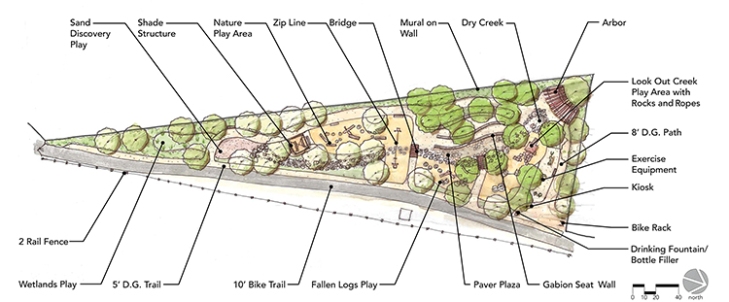BY MADELINE BODIN

The video game Minecraft has become a new tool for community engagement.
FROM THE MARCH 2018 ISSUE OF LANDSCAPE ARCHITECTURE MAGAZINE.
In Anaheim, California, the children couldn’t wait to show Pamela Galera, ASLA, the zip lines and tree houses in their parks. As she visited their creations, Galera, a landscape architect and planner for the City of Anaheim, saw the road on one side of the site and the river on the other, just as they are in real life. The landscapes, created by the kids using the video game Minecraft, were blocky by nature, but three dimensional, and from their laptops, they could explore the park designs from all directions.
Galera had no experience with Minecraft until recently, when Mojang, the company that created Minecraft, asked the City of Anaheim to use the game to help design a park. The design project would be featured at a Minecraft convention held in the city. “I am not a video game player,” she says, “so I had my concerns.” Mojang (now owned by Microsoft) had worlds of experience. In 2012, Mojang partnered with the United Nations Human Settlements Programme (UN-Habitat) to launch an initiative called Block by Block, which employs Minecraft to help communities reconceive public spaces.
Block by Block’s first project was a playground in Nairobi, Kenya, in 2012. “Young people are a big part of the population in much of the world,” says Pontus Westerberg, the program officer for UN-Habitat’s urban planning and design branch. Yet it’s rare for young people to attend public planning meetings. Block by Block brings city officials and design professionals together with residents, especially children. The group is presented with an accurate and scaled Minecraft model of the existing space. These models are created for Block by Block by two third-party organizations, Minecraft Mexico and BlockWorks. Small groups of stakeholders then build their vision for the site using Minecraft.

A traditional design concept drawing of the play area after the children’s input. Image courtesy MIG, Inc.
“It can be hard to communicate the constraints of a project,” Galera says. Reading plans and elevations and being able to imagine a three-dimensional design from a two-dimensional drawing are skills that take time to learn. Most people, but particularly children, pick up the conventions of Minecraft more quickly. Just about everyone intuitively understands Minecraft’s three-dimensional models. “That’s why Minecraft is valuable,” Galera says. “We can share ideas in a way that’s understandable to everyone.”
The Block by Block program quickly expanded beyond playground design to all kinds of public spaces, and now is responsible for 50 projects around the globe, Westerberg says. Anaheim was a pilot for a U.S. expansion of the project that will train local professionals in the Minecraft-based community engagement method. After just a few weeks of working with Minecraft, Galera felt confident using it. So did the children who had never used Minecraft. “They just took off,” she says. “In a long career, it was a fulfilling moment.”